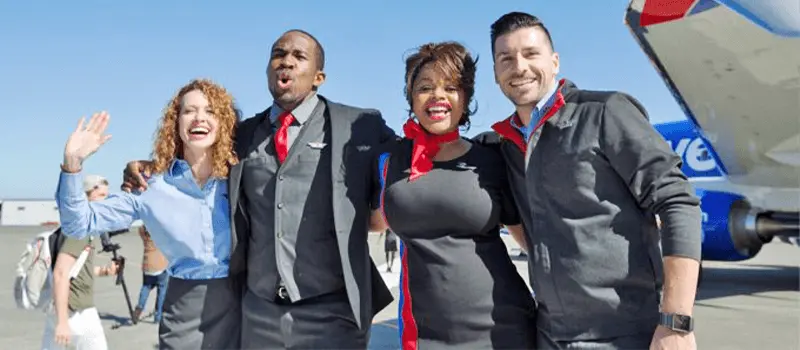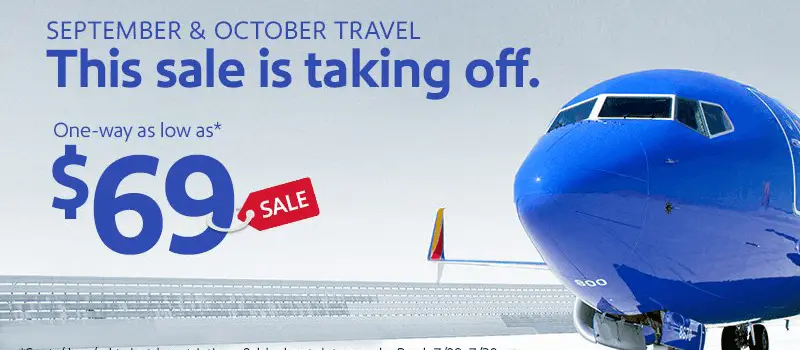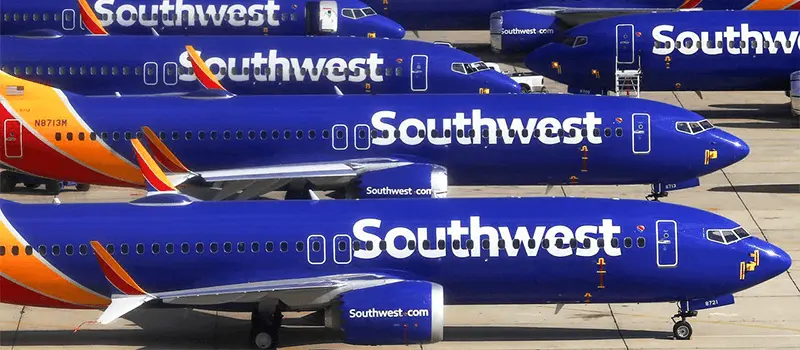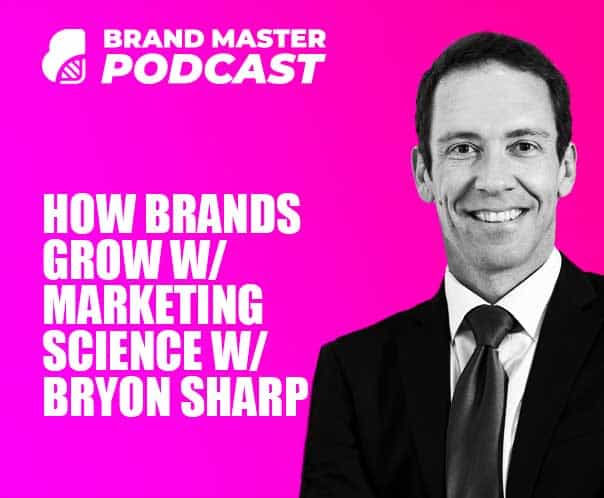Few brands ever achieve Cult Status, and no brand in the airline industry can boast a cult following quite like Southwest Airlines.
From a small interstate airline operating out of Dallas Texas where the brand was born back in 1967, Southwest now services over 100 destinations across North America and The Caribbean.
A story of hot pants, whisky, peanuts, caring and some light-hearted humour, this article breaks down the Southwest Airlines Brand in this case study.
The Brand History

The history of Southwest began in 1967 at a hotel bar in San Antonio, Southwest founders Herb Kelleher and Rollin King took out a napkin and scribbled three points of a triangle representing their novel idea.
An airline that would connect the three main cities of Texas; Dallas, Huston and San Antonio.
For 8 years from 1971, Southwest Airlines operated as an interstate only carrier.
It wasn’t until 1979 when U.S. President Jimmy Carter deregulated air travel in the USA, did Southwest really take off.

40 years later, the Southwest Brand has achieved cult status with its customers with a low cost, low stress no nonsense approach to air travel, which has seen it grow to become the largest airline operating in the U.S.
But how did it get there. What makes Southwest so different to all the other airline brands out there and why do their customers love them so much?
Case Study:
Brand Positioning Strategy

When the founders of Southwest were sitting in that bar in San Antonio, their conversation about what would make them different centred on pricing.
Founder Herb Kelleher summed up their position succinctly when he said
I can teach you the secret to running this airline in thirty seconds. This is it: We are the low-fare airline
Low cost pricing as a standalone strategy is nothing new and never tends to last long, but they weren’t selling a commodity that was easily picked up and sold at a cheaper price.

They were building an airline from the ground up and integrating this positioning strategy into every single decision of operations making it next to impossible for existing, more established airlines to replicate.
Their deliberate decision to stock their fleet with only Boeing 737’s had a dramatic impact on their operating, maintenance and staff training costs that was unparalleled.
PRO Brand Strategy BluePrint
Build Brands Like A Pro Brand Strategist

A Competitive Brand Advantage

From the early days in Texas, Southwest has run a tight and efficient ship through their business operations. A competitive advantage they’ve never relinquished.
Where the airline has really excelled however has been through a deep focus on customer experience, low-cost pricing and logistics solutions.
But Southwest is not all love cuddles and peanuts.
Their outside the box thinking and innovation has moved the industry forward and their development of company culture has positioned them as an airline their motivated employees believe in.
Explore Brand Strategy
Programs & Tools
Helpful Brand Personnel

We’ve all had bad experiences with air travel.
Having emigrated to Australia in 2001, I have traveled back to my home country of Ireland more times than I can remember so I’m well versed on how airline staff impact the travel experience.
Some make you feel like you’ve asked them to walk over hot coals when all you’ve asked for is an extra pillow, while others make you feel like they’d actually walk over hot coals for you.

Southwest understands this gripe and has gone to extraordinary lengths to make sure the people they hire are aligned with the brand experience.
Helpfulness is a core value of the brand and ensuring their employees are the most helpful in the industry has given them a distinct advantage.
A Flexible Brand Experience

The Southwest Airlines leadership are people who understand the stresses of air travel and make it their business to reduce that stress wherever possible.
To put it simply, Southwest make flying easier.
Traditionally, the airline industry is full of red tape and “Gotcha” terms and conditions that sting customers for anything outside the “Buy your ticket and get on the plane” model.

At Southwest, policies and procedures have been softened at every corner including a cancellation policy that would make other airline CEO’s look like they were sucking a lemon.
You want to cancel your flight 30 minutes prior to take-off? No Problem.
Pricing Less And Rewarding More

More often than not, a better overall brand experience is a differentiation strategy that comes with a premium price.
And it makes sense. If you want the best services you can’t expect to pay the lowest price. Price and quality are the usual trade-off.
Not only do Southwest offer one of the best experiences in the business, they do it with the lowest prices which is a brand advantage accessible to them via their low operating cost strategy.

Compared to their closest competitors such as Delta Airlines and American Airlines Southwest’s pricing is far more affordable.
But Southwest doesn’t stop there. On top of the savings they afford their customers, they also lavish gifts on them through one of the best rewards programs in the industry.
It’s no wonder their brand loyalty soars so high.
A Nimble And Innovative Brand

Southwest’s flexible business model allows the airline to stay ahead of the curve with nimble decision-making and forward thinking.
Always focused on customer experience, the airline regularly upgrades its fleet of airplanes and expands its army of loyal followers and service destinations.
Case Study:
Target Market

Commercial airline travel emerged after the Second World War though this wasn’t an inexpensive experience.
There were multiple classes including luxurious lounges where three course meals were served on bone china with champagne in crystal glasses.
Air travel up to the late 60’s was an exclusive luxury reserved for those who weren’t short of a dollar.
When Southwest emerged, they shook up the industry as the first “Budget Airline”.
An Everyday Target Audience

So, who is Southwest’s Target Market?
Cost-conscious, no-frills travellers looking for the best value for their dollar.
Air travel wasn’t just for the wealthy anymore. Southwest expanded the market by slashing costs and today Southwest’s target audience includes
Families
Young travellers
Businessmen and Women
Frequent Flyers
Holiday Makers
They’ve distances themselves from exclusivity and the segment that expects it and have masterfully appealed to their audience by focusing on what’s important to them.
Low cost, simplified air travel with a pleasant experience.
Case Study:
Brand Messaging & Marketing

Although their low-cost position put Southwest on the map, it’s not what has keep them there.
Today, budget airlines have flooded the market and have become a pain-point in-and-of-itself for many seasoned travelers.
The cost-cutting model has become so intense that bag size arguments and hairdryer unloading have become common scenes at check-in gates the world over.
This is why the other angle of their market position focus on the customer experience and their messaging is such a breath of fresh air.
Brand Language & Tone

Southwest isn’t like other airlines. They don’t speak with a robotic corporate voice with overly corporate language and tones.
Southwest has such high brand advocacy rates because they are a brand of people, speaking to people, making connections just as people do.
Modern brands are human brands and there a few examples better than Southwest Airlines
The Social Branding Approach

Southwest started a 30-person “Social Business” department in 2015 that has become a central figure across the entire business operations.
This social department has made the brand seem even more human and approachable as it’s used for everything from customer service to marketing to crisis management.
In 2016 the airline suffered a massive technology failure causing thousands of flights to be cancelled and an inevitable barrage of complaints from some of the 250,000 unhappy customers.
The social team worked relentlessly to respond as many customer complaints as possible, which were all loaded with authenticity and humility.
We're so sorry to hear about the cancellation and we cannot thank you enough for your patience with our services today. ^AC
— Southwest Airlines (@SouthwestAir) July 22, 2016
Branding With Human Emotion

Let’s face it. When we think of airlines we don’t tend to get become overcome with affection because our memorable experiences are usually on the wrong side of the word “love”.
Southwest however, have made it their mission to make as many of their customers feel that way about the brand.
Their messaging is warm, their manner is friendly, their approach is human and they do everything they can to show the “Love”.
This is a philosophy they’re so committed to, they use the “Ticker Code” “LUV” on the New York Stock Exchange and use a heart icon wherever the brand needs to be represented visually.
This is a brand with personality and authenticity that genuinely puts their customers first.
Brand Loyalty & Intimacy

The terms brand loyalty and brand intimacy are interconnected and along with advocacy are the holy grail of branding.
These terms are reserved for brands that just get it.
They supersede transactional relationships and take a meaningful place in the hearts and minds of their customers.
Loyalty Is A Human Emotion

Being human is a philosophy that Herb Kelleher adopted early on.
He encouraged informality and wanted staff to have fun in their jobs. This human touch has remained a philosophy of the brand over 40 years later.
Today, employees are encouraged to be themselves and a strong brand culture and their belief in what they do is playing out at check-in desks and in the skies across America.
In this video, a flight attendant is captured doing things a little differently.
Brand Loyalty Leads To Brand Intimacy

In their annual brand intimacy study MBLM ranked Southwest Airlines the most intimate brand in the travel industry for three years on the trot.

According to MBLM:
Southwest has been able to distinguish itself and cultivate Brand Intimacy, creating a significant advantage because consumers are more willing to engage with, use, and pay a premium for intimate brands. Whether it is the heart logo or the focus on customer service, Southwest’s brand is built on an emotional foundation that is uncommon among travel brands.
Most notably, Southwest Airlines is by far the most intimate travel brand with the market segment earning under $100k. A sure sign of their strong position in the market for their intended target audience.

Over To You
Soutwest Airlines is an example of a brand that understands their audience.
First, they know their challenges and make it a priority to take those challenges away and make flying as easy as possible.
Then, they make the relationship about more than just a transaction.
Yes, Southwest solve a problem for their customers; yes their customers pay for that privilege but that’s not what drives brand intimacy.
Southwest customers feel affection towards the brand because they make their lives easier and they make human connections as they do it.
That is what every brand must strive for.
Let me know your thoughts in the comments below!
On-Demand Digital Program
Brand Master Secrets
Make the transition from hired-gun to highly valued brand strategist in less than 30 days. The systems, frameworks and tools inside this comprehensive program are all you need to level up.








Love your in-depth analysis Stephen!
Cheers Vincent… glad you enjoyed it
Hello from Belfast. The best city in Ireland obviously. Brilliant stuff, been following your stuff for a while and you lay things out really clearly. Nearly ready for onboarding. that was bad sorry.
What about ye…. ???? ????